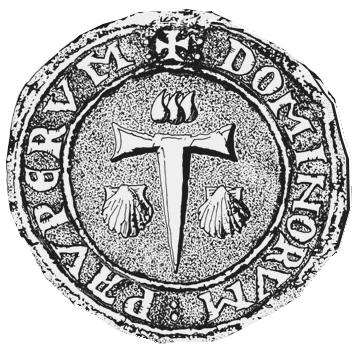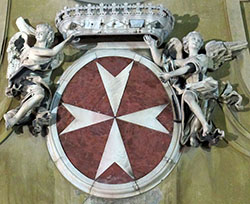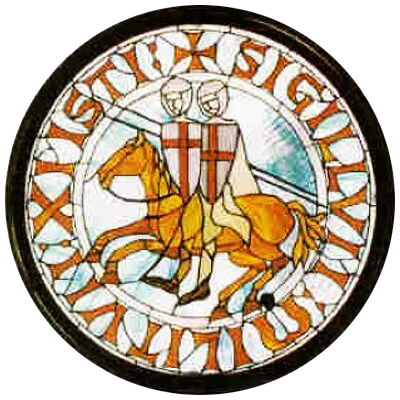THE CARE OF PILGRIMS
The Pilgrimage
The beginning of the first pilgrimages, understood as a fundamental practice in the religiosity of the Middle Ages, dates back to the 11th century. The pilgrims, in increasing numbers, set out to travel the routes that led to the symbolic places of medieval Christianity: Jerusalem, Rome and Santiago de Compostela. Medieval man saw in pilgrimage a way to search for the Faith, the experience of detachment from all earthly securities, the path to the Kingdom of Heaven. It was not intended only as atonement for sins through the hardships of the journey, but a personal journey of encounter with God. Those returning from the experience of the pilgrimage were held in high regard by the whole community that welcomed them back, as the bearer of one a particular state of grace, acquired by the value of the journey and by being voluntarily uprooted from one’s own affections and from one’s own reality.
Pilgrimage is one of the oldest and most widespread phenomena in human history. While traveling, we experience what the desert fathers called xeniteia, the xenos being, “foreign”, without any protection, surrounded by unknown languages and landscapes. A disorientation that allows you to be freer, in research, in reflection.
Hospitality – Hospitals or spitals
In medieval times, this term was used to indicate a place intended to house the needy. The hospital, therefore, was not intended as a place of care for the sick but their main function was to welcome pilgrims, and especially those who were unable to pay for a bed in an inn. For this reason, hospitals were located along the roads that led, from all over Europe, to places of pilgrimage: Rome, Jerusalem, Santiago de Compostela. There were hospitals in the cities, but also outside the walls, to give refuge to pilgrims who had arrived late in the evening, when the city gates were now closed. They were religious institutions, often belonging to a monastery or a parish and were maintained thanks to the fruits produced by bequests of citizens and alms. They weren’t able to offer much: generally a bed or rather a straw mattress in a common room. Often there was no provision for food to be offered to pilgrims, who, if able to walk, could obtain sustenance by begging for alms. In the area we are going to cross, there were several structures intended for the reception of both the sick and pilgrims. Most of them are located on the Via Francigena which, passing through Lucca and Altopascio, crossed the territory of Capannori. We mention a few.
San Concordio di Rimortoli – The hospital church built in 1122 was part of the Piviere di Segromigno, and was dedicated to Marco Evangelista, Maria, Maddalena and Concordio. Until the early 1800s it belonged to the Sisters of S. Nicolao Novello.
The Spedale Sant’Antonio di Camigliano – founded by Luigi Boccella. The plague epidemic that took place in 1348 leads us to believe that this was the year of construction. The elders of Camigliano tell of the existence of a cemetery (handed down orally for generations) behind the Villa Torrigiani and therefore in the vicinity of the church and the hospital. In the year 1520 the hospital passed under that of San Luca following a letter from the bishop who thus intended to give a single direction to the many hospitals scattered throughout the diocese. In 1610 the hospital was no longer active.
San Leonardo in Treponzio (Capannori) – ancient church (documented in 1115 and probably built on a church of 782) built in blocks of square sandstone and arranged in rows, the archivolt of the portal is in marble and is attributed to the Guidetto school. The hospital was born, probably around 1100 by the Knights of the Tau and in 1426, together with the church of San Leonardo, they joined the Monastery of Santa Maria di Fregionaja.
Casa dei malati (House of the sick) of Lucca – The Spedale was located in Campo di Ruchi between the Francesca road and the Pistoiese in the locality of Macario “Machari” probably built in 1267 by Benedictine monks from the monastery of Guamo.
Hospital of San Matteo and Pellegrino – Pieve di Lunata – Ancient documents attest to the existence in the year 812 of a small temple dedicated to San Martino, which was later transformed into a hospice for pilgrims. Among the documents relating to the hospital there is an inventory from 1233. The hospital, under the patronage of many citizens and the Prior of S. Frediano, is included in a list dated 18/05/1520 of Hospitals annexed to that of San Luca . It was suppressed in 1776.
The Knightly Orders for the protection of pilgrims
The Knights of the Tau
 Many aspects of this order are poorly documented and the sources often sink into legend rather than history. It all began with the construction by twelve knights of Lucca, in Altopascio, along the Via Francigena, of a hospice center that became one of the most important of the time, where hospitality was the mission of this Chivalric Religious Order, which exercised the reception and assistance on the basis of rigid and scientifically established dictates. Since it was intended almost exclusively for pilgrims and the poor, it was dedicated to San Jacopo, who was later joined by San Eligius and San Cristoforo. Over time, this hospital received the patronage of the bishopric and land donations from private individuals, finding itself, in a few decades, to hold and manage a large land patrimony that led it to be, in 1260, the richest ecclesiastical institution in Lucca. Although there was no evidence, there was a widespread rumor that Matilde di Canossa, who owned a large and sumptuous villa in nearby Vivinaia, today Montecarlo, played an important role in the foundation of the hospital. The Rule adopted by the order provided for provisions on accommodation for travelers, based on the income, illness and needs of each one; on the nourishment of the guests and their care. The Rule provided for the permanent presence in the hospital of four doctors and two lay surgeons (surgery was forbidden to religious at that time), equipped with the necessary skills in medicine and in the preparation of medicines; they had to be able to deal with the most common diseases at that time (smallpox, typhus, cholera) and all the most frequent pathologies for those who went through the woods and roads. The hospitallers were divided into friars priests, the servants, the laity with well-defined tasks and the sisters, women with the functions of nurses. The knights of this order had among their tasks, even the care and restoration and maintenance of roads, bridges and the cultivation of agricultural land.
Many aspects of this order are poorly documented and the sources often sink into legend rather than history. It all began with the construction by twelve knights of Lucca, in Altopascio, along the Via Francigena, of a hospice center that became one of the most important of the time, where hospitality was the mission of this Chivalric Religious Order, which exercised the reception and assistance on the basis of rigid and scientifically established dictates. Since it was intended almost exclusively for pilgrims and the poor, it was dedicated to San Jacopo, who was later joined by San Eligius and San Cristoforo. Over time, this hospital received the patronage of the bishopric and land donations from private individuals, finding itself, in a few decades, to hold and manage a large land patrimony that led it to be, in 1260, the richest ecclesiastical institution in Lucca. Although there was no evidence, there was a widespread rumor that Matilde di Canossa, who owned a large and sumptuous villa in nearby Vivinaia, today Montecarlo, played an important role in the foundation of the hospital. The Rule adopted by the order provided for provisions on accommodation for travelers, based on the income, illness and needs of each one; on the nourishment of the guests and their care. The Rule provided for the permanent presence in the hospital of four doctors and two lay surgeons (surgery was forbidden to religious at that time), equipped with the necessary skills in medicine and in the preparation of medicines; they had to be able to deal with the most common diseases at that time (smallpox, typhus, cholera) and all the most frequent pathologies for those who went through the woods and roads. The hospitallers were divided into friars priests, the servants, the laity with well-defined tasks and the sisters, women with the functions of nurses. The knights of this order had among their tasks, even the care and restoration and maintenance of roads, bridges and the cultivation of agricultural land.
The friars wore a long black cloak on which an awl-shaped image reminiscent of the letter Tau stood out. The religious symbolism was a reference both to the tools used and to the crutch, a support for pilgrims. The letter Tau, last of the Greek alphabet, meant perfection and salvation.
The Rule of the friars also dictated particular attention to the professional ethics of the doctor who had to be deeply motivated, moved by a strong sense of duty, attentive to the human aspect and not only to the clinical one of the patient. The fame of the Altopascio hospital also spread abroad with the foundation of some branches. In 1180, the order settled in Paris, outside the city walls, where the church of Saint Jacques du haut Pas now stands and in Spain, where the Magione had dependencies in Astorga, Pamplona and Tortosa or, again, in England and in Germany.
The Knights of the Order of the Hospitallers
 In 1099, the order of the Hospitallers of St. John of Jerusalem originated from the work of Brother Gerardo Sasso, an Italian Christian monk. The latter, regent of the hospital and church of Amalfi, was its first grand master and was proclaimed blessed by the Catholic Church. The order had the mission of helping and treating the sick and injured on their way to pilgrimage to the Holy Land. Their name derives from the hospital, which later became a hospital, the place where the sick and injured receive care. Over time, the order joined the military mission to rescue the wounded, aimed at conquering the territories of the Holy Land. Settled in Rhodes which they obtained for over two centuries, they became one of the major naval powers in the Mediterranean, facing the Arab and Ottoman populations who tried to regain the lost lands and fighting against the Berber pirates who infested the Mediterranean. After a long series of vicissitudes they obtained permission to settle in Malta with the task of repelling the Ottoman raids, obtaining their greatest victory in 1565 by repelling the great siege of Suleiman. In 1571 the order, renamed the Order of Malta, became part of the powerful league between Spain, Venice, the Pontiff, the Duke of Savoy, the Grand Duke of Tuscany, Genoa and the Kingdom of Sicily, he participated in defeating the Turkish army commanded by Alì Pascià. Although he also assumed a military role, he continued to pursue his original charitable mission and created in Malta the largest hospital of the time where in the following years friends and enemies from all sides were treated indiscriminately. Other vicissitudes saw them opposed to Napoleon and finally recognized by Pope Pius IX in 1854. Today, having become Sovereign Military Order of Malta, he is based in Rome and continues to perpetrate the ancient mission of assistance, working against diseases, misery, and ignorance through various hospitals and works located in various locations. The Knights originally wore a black tunic, similar to the Benedictine order, to which was subsequently added the cloak, always black, and a white eight-pointed cross on the chest on the side of the heart, which later became the symbol of the order. This eight-pointed cross was the so-called Amalfi cross.
In 1099, the order of the Hospitallers of St. John of Jerusalem originated from the work of Brother Gerardo Sasso, an Italian Christian monk. The latter, regent of the hospital and church of Amalfi, was its first grand master and was proclaimed blessed by the Catholic Church. The order had the mission of helping and treating the sick and injured on their way to pilgrimage to the Holy Land. Their name derives from the hospital, which later became a hospital, the place where the sick and injured receive care. Over time, the order joined the military mission to rescue the wounded, aimed at conquering the territories of the Holy Land. Settled in Rhodes which they obtained for over two centuries, they became one of the major naval powers in the Mediterranean, facing the Arab and Ottoman populations who tried to regain the lost lands and fighting against the Berber pirates who infested the Mediterranean. After a long series of vicissitudes they obtained permission to settle in Malta with the task of repelling the Ottoman raids, obtaining their greatest victory in 1565 by repelling the great siege of Suleiman. In 1571 the order, renamed the Order of Malta, became part of the powerful league between Spain, Venice, the Pontiff, the Duke of Savoy, the Grand Duke of Tuscany, Genoa and the Kingdom of Sicily, he participated in defeating the Turkish army commanded by Alì Pascià. Although he also assumed a military role, he continued to pursue his original charitable mission and created in Malta the largest hospital of the time where in the following years friends and enemies from all sides were treated indiscriminately. Other vicissitudes saw them opposed to Napoleon and finally recognized by Pope Pius IX in 1854. Today, having become Sovereign Military Order of Malta, he is based in Rome and continues to perpetrate the ancient mission of assistance, working against diseases, misery, and ignorance through various hospitals and works located in various locations. The Knights originally wore a black tunic, similar to the Benedictine order, to which was subsequently added the cloak, always black, and a white eight-pointed cross on the chest on the side of the heart, which later became the symbol of the order. This eight-pointed cross was the so-called Amalfi cross.
The Knights Templar
 The military order of the Templars was founded in 1119 on the initiative of the French Hugo de Payns to protect pilgrims who went to the Holy Land from incursions by “infidels” and to support the Christian kingdom that reigned over Jerusalem at that time. It owes its name to its first seat, a palace in Jerusalem where the Temple of Solomon once stood. The order, governed by a Grand Master, was supported by Bernard of Clairvaux who wrote the rule and worked to ensure that it was approved by the Council of Troyes. They belonged there exclusivity members of the European nobility; their robe bore a red cross painted on a white background. Their motto was Non nobis Domine, sed nomini tuo da gloria (not to us, Lord, but to your name you give glory). Together with the military purposes, he carried out assistance activities, especially in places scattered along the great pilgrimage roads.
The military order of the Templars was founded in 1119 on the initiative of the French Hugo de Payns to protect pilgrims who went to the Holy Land from incursions by “infidels” and to support the Christian kingdom that reigned over Jerusalem at that time. It owes its name to its first seat, a palace in Jerusalem where the Temple of Solomon once stood. The order, governed by a Grand Master, was supported by Bernard of Clairvaux who wrote the rule and worked to ensure that it was approved by the Council of Troyes. They belonged there exclusivity members of the European nobility; their robe bore a red cross painted on a white background. Their motto was Non nobis Domine, sed nomini tuo da gloria (not to us, Lord, but to your name you give glory). Together with the military purposes, he carried out assistance activities, especially in places scattered along the great pilgrimage roads.
Well seen by the church and by the populations, he saw the number of adherents grow rapidly and had numerous bequests and donations so as to enormously enrich his wealth and his political, military and financial power to the point of arousing the mistrust and hostility of some European states. , particularly of the French. Philip the Fair, who had contracted huge loans with the Templars to finance the war in Flanders and could not honor the debt, waged a ruthless fight against the Order in 1307, having the Templars arrested in French territory.
A trial for heresies and immorality was set up and, although the charges were not proven, it was sentenced. Even the Church withdrew its support, subject to pressure from the King of France and decreed the excommunication and dissolution of the Order. The leaders of the Order were burned at the stake, the Order’s assets partly requisitioned and confiscated by the King of France, partly assigned to the Order of Rhodes (later called the Order of Malta). In some states the Templars changed their name and continued to carry out their activities (with the exception of the military ones) as the Military Order of Montesa, the Military Order of Christ, and other denominations The activity of the Templars also took place in Spain: they gave a great contribution in the process of the reconquista fighting many battles in support of the armies of the Spanish kings and princes. Along the routes of the Camino de Santiago they have left traces that are still visible today: the Castle of Ponferrada, the hermitage of Santa Maria in Eunate, the church of the Crucifix in Puente la Reina, the octagonal church of Torres del Rio.